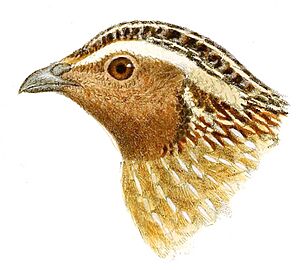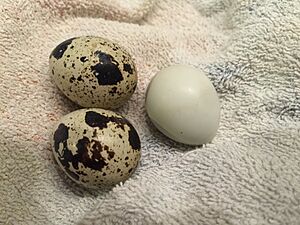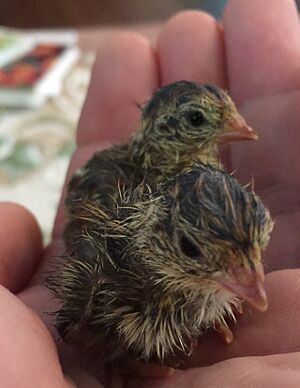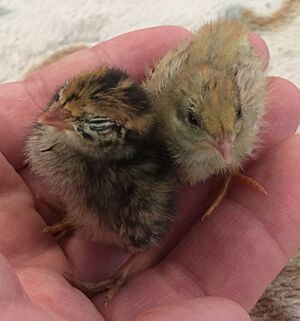Japanese quail facts for kids
Quick facts for kids Japanese quail |
|
|---|---|
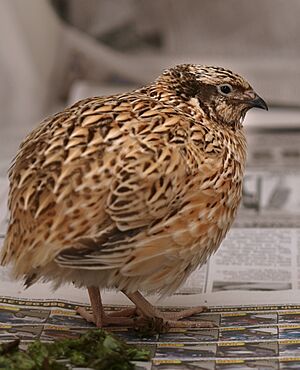 |
|
| Golden speckled is just one of the many names for this color type of Coturnix japonica | |
| Conservation status | |
| Scientific classification | |
| Genus: |
Coturnix
|
| Species: |
japonica
|
The Japanese quail (Coturnix japonica), also called the coturnix quail, is a small bird found in East Asia. People first thought it was just a type of common quail, but now it's known to be its own unique species. Japanese quails have been important to humans for a long time, since the 12th century. Today, they are still very important in farming and for scientific studies. In the places where they live, there are usually lots of them. There are many different kinds of Japanese quails now because of breeding. Some types you might see include Pharaoh, Italian, and Tibetan.
Contents
What is a Japanese Quail?
The Japanese quail was officially described by two scientists, Coenraad Jacob Temminck and Hermann Schlegel, in 1848. They gave it the scientific name Coturnix vulgaris japonica. Now, it belongs to a group of birds called Coturnix.
This quail used to be considered the same as the common quail. However, scientists found that where their homes meet, they don't mix and have babies together. Also, when they do have babies in captivity, those babies often can't have their own babies easily. Because of this, the Japanese quail is now seen as its own separate species. It doesn't have any different types or subspecies.
What Do Japanese Quails Look Like?
Japanese quails look different as they grow up. When they are chicks, both male and female quails look the same. Their heads are a light brown color with small black spots. Their wings and back are also light brown, and their back has four brown stripes. A light yellow-brown stripe runs down the top of their head.
Adult male and female Japanese quails look different, which helps tell them apart. Both sexes are mostly brown. However, the marks on their throat and chest, and the exact shade of brown, can change a lot. Female quails have dark spots on their light chest feathers. Male quails, on the other hand, have a solid dark reddish-brown chest with no spots. This reddish-brown color also shows up on the male's cheeks, while females have cream-colored cheeks. Some male quails even have a white collar, which females never do.
It's important to remember that while this is how wild quails look, people have bred many different colors and patterns of domesticated quails. Most of these types still look different between males and females. However, some types, like the Texas A&M and English white quails, are hard to tell apart just by their feathers.
Males are usually smaller than females. Wild adult quails weigh about 90 to 100 grams. Domesticated quails are a bit heavier, usually 100 to 120 grams. But some quails bred for meat can weigh up to 300 grams!
Compared to the common quail, the Japanese quail has darker feathers on its back with more contrast. Its belly is also a deeper reddish-brown. During breeding season, male Japanese quails have special reddish-brown throat feathers. These change to long, pale feathers when it's not breeding season. This doesn't happen with the common quail.
Quail Sounds
Scientists have found about 28 different sounds that Japanese quails make. These sounds depend on what's happening and what the quail is doing. Male and female quails make different sounds even when they are reacting to the same thing. Most of their calls are learned by five weeks old, but they can still change until the quail is fully grown. The typical crow of a male Japanese quail has two short sounds followed by a longer, trilling sound.
Male quails with a mate make different crowing sounds than males without a mate.
Where Do Japanese Quails Live?
Japanese quails mostly live in East Asia and Russia. This includes countries like India, Korea, Japan, and China. While some quails stay in Japan for the winter, most fly south to places like Vietnam, Cambodia, Laos, and southern China. These quails have also been found in many parts of Africa, including Tanzania, Malawi, Kenya, and Egypt.
They mostly breed in East and Central Asia, in areas like Manchuria, southeastern Siberia, northern Japan, and the Korean Peninsula. But they have also been seen breeding in some parts of Europe and Turkey.
The Japanese quail usually lives on the ground. It likes to stay in areas with lots of plants to hide from predators. So, you can find them in grassy fields, bushes near rivers, and farm fields with crops like oats, rice, and barley. They also like open areas such as steppes (flat grasslands), meadows, and mountain slopes close to water.
How Japanese Quails Behave
People used to think Japanese quails couldn't taste much. For example, they couldn't tell the difference between different types of sugars. However, studies now show they can taste a little bit. They prefer sugary water over plain water and avoid salty water.
Even though they have a good sense of smell, we don't know much about how they use it. But some studies show they can smell certain things. For instance, they can detect some pesticides and avoid food with bad proteins just by smelling them.
Japanese quails can see things in front of them with both eyes, which helps them see far away. To keep an object in focus while walking, they move their heads. They can also see colors, and their color vision is better than their ability to see shapes. We don't know much about their hearing, but they can tell the difference between different human speech sounds.
These quails also love to take dust baths. They do this many times a day. When dust bathing, they scratch the ground with their beak and legs to loosen the dirt. Then, they use their wings to throw the dust into the air. As the dust falls, they shake their body and ruffle their feathers to get a good coating. This behavior helps them keep their feathers clean and get rid of parasites.
Reproduction and Life Cycle
The way male and female Japanese quails pair up can be different. They have been seen to have both one partner (monogamous) and multiple partners (polygamous). One study of domesticated quails showed that females often bond with one or two males.
Japanese quails are most active in breeding during the summer.
Eggs are usually laid a few hours before it gets dark. The mother quail starts sitting on the eggs (incubation) as soon as the last egg is laid. This usually lasts about 16.5 days. Female quails do most of the incubation. As the eggs get closer to hatching, the female becomes less tolerant of the male and will eventually chase him away. This means the female also takes care of all the newly hatched chicks by herself.
The weight, color, shape, and size of eggs can vary a lot among different female quails. However, for any single female, her eggs will usually look very similar. Eggs are often mottled (spotted) with a background color that can be white, blue, or light brown. Depending on the type of Japanese quail, eggs can weigh from 8 to 13 grams, but the average is 10 grams. Older female quails tend to lay larger eggs.
What Do Japanese Quails Eat?
The Japanese quail's diet includes many types of grass seeds, like white millet. They also eat different insects, their larvae (young insects), and other small invertebrates (animals without backbones).
These quails mostly eat and drink at the beginning and end of the day. This behavior follows the amount of daylight (photoperiod). However, they will still eat and drink throughout the day too.
Japanese Quails and People
How They Became Domesticated
The first records of Japanese quails being kept by humans are from Japan in the 12th century. But some clues suggest they might have been tamed even earlier, around the 11th century. These birds were first raised for their beautiful songs, and people even had singing contests with them.
In the early 1900s, Japanese breeders started to breed quails to lay more eggs. By 1940, the quail egg business was doing very well. However, World War II caused almost all the quails bred for singing and most of those bred for eggs to be lost. After the war, the few quails left were used to rebuild the industry. All the commercial and lab quails we see today are thought to come from those few surviving birds.
Helping Wild Quail Populations
The Japanese quail is very similar to the common quail. Because they are so alike and wild common quail numbers have dropped in Europe, Japanese quails are often bred with common quails to create mixed birds. These mixed birds are then released to help increase the wild quail populations. Countries like Greece, France, and Italy release thousands of these mixed quails every year. They often release them right before hunting season starts. These mixed quails look almost exactly like the native common quails. However, some people worry that mixing the species could be bad for the native quail populations in the long run.
Quails for Food and Eggs
The Japanese quail is easy to manage, grows quickly, and is small. It can also lay many eggs. Because of this, it is farmed in large numbers all over the world. Japan, India, China, and the United States all have big businesses farming Japanese quails.
Japanese quails give developing countries a steady supply of meat. For developed countries, they are a good alternative to chicken. But the quail's biggest value is in its eggs. Domesticated Japanese quails can lay up to 300 eggs a year! They are also very good at turning their food into eggs efficiently.
Quails in Science
Scientists became very interested in the Japanese quail for research after 1957. Groups at the University of California and Auburn University suggested they would be great for medical studies. Now, they are used a lot in labs for research. They help scientists study genetics (how traits are passed down), nutrition, physiology (how bodies work), pathology (diseases), embryology (how babies develop), cancer, behavior, and how toxic pesticides are.
Japanese quail eggs have even traveled into space on several Soviet and Russian spacecraft. In March 1990, eggs on the Mir space station successfully hatched!
See also
- List of birds of Japan
- Lists of Korean birds
- Quails in cookery



